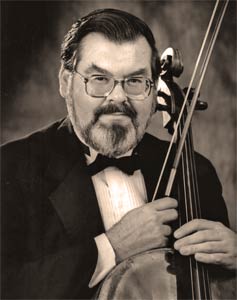The Martha Blakeney Hodges Special Collections & University
Archives is pleased to announce the donation of the collection of Douglas B. Moore
to the UNCG Cello Music Collection. Douglas Moore was Professor of Music at
Williams College from 1970 to 2007, and cellist with the Williams Chamber
Players and the Williams Trio. His Bachelor of Music degree in cello is
from Indiana University, where he studied with
Fritz Magg and János Starker,
and his Masters and DMA degrees are from The Catholic University of America in
Washington DC.
Moore has performed at the National Gallery of Art in Washington DC,
and at the Great Music West (Utah), Saratoga Baroque, Music Mountain, and
Newport music festivals. He has been an artist/faculty member at the Manchester
(VT) Music Festival (1998-2008) and Kansas City Cello Clinic. He has been
principal cellist with the Great Music West Festival Orchestra in Utah, the Albany
(NY) Symphony, Berkshire Symphony at Williams College and the Lake George Opera
Festival orchestra. From 1991 the 1995 he was a member of the Saratoga Chamber Players,
based in Saratoga Springs NY. He has also conducted cello orchestras at cello
congresses, cello camps and universities, and given frequent master classes.
In 1976, Moore played the world premiere performance of the Cello
Sonata, Op. 78 by Arthur Foote. His edition of the complete music for cello and
piano by Foote was published in 1982 by A-R Editions on the Recent Researches
in American Music series. The first modern-day performance of Foote's Cello
Concerto took place in 1981 with Douglas Moore as soloist. Since then, he has
performed the work with orchestras in Connecticut, Minnesota, Virginia, Massachusetts,
Vermont, Illinois and Iowa. He has recorded music by Foote, Farwell, Cadman,
Arensky, Rachmaninov, and Kechley on the Musical Heritage Society, Grand Prix
and Liscio labels.
Moore has published over forty original arrangements through
his publishing company,
PlayMooreCello, including Sousa’s
Stars and Stripes
Forever and Rossini’s
Barber of Seville Overture. His arrangements have been
recorded by Yo-Yo Ma, the Saito Cello Ensemble of Japan and the Boston Cello
Quartet. Additionally, Moore has published nearly 3 dozen modern editions of late
18th and early 19th century
duos for violin and cello, most of which have never
appeared since their first publication.
The
Cello Music Collection of the Special Collections and University Archives contains sheet music (manuscript and published), monographs, serials, audio-video recordings, personal papers, and artifacts associated with cellists noted for their distinguished contributions in the areas of composition, performance, pedagogy, and research. Douglas Moore is the twelfth cellist represented within the
UNCG Cello Music Collection. Consisting of the archival music collections of Luigi
Silva, Elizabeth Cowling, Rudolf Matz, Maurice
Eisenberg, János Scholz, Fritz Magg, Bernard Greenhouse, Laszlo
Varga, Lev Aronson, Lubomir Georgiev, Marion Davies, and Douglas Moore,
the Cello Music Collection at The University of North Carolina at Greensboro constitutes
the largest single holding of cello music-related material worldwide.



































